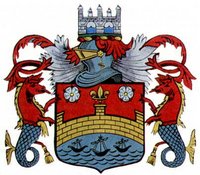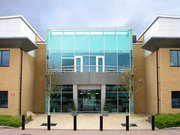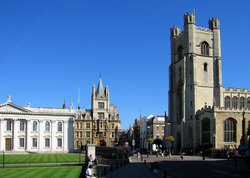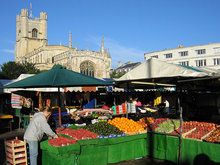Cambridge
|
|
- This article is about Cambridge in the English county of Cambridgeshire; see also other places called Cambridge.
| City of Cambridge | |
|---|---|
| Template:GBdot-small |  Shown within Cambridgeshire |
| Geography | |
| Status | City (1951) |
| Region | East of England |
| Admin. County | Cambridgeshire |
| Area - Total | Ranked 316th 40.70 km² |
| Admin. HQ | Cambridge |
| ONS code | 12UB |
| Coordinates | Template:Coor dms |
| Demographics | |
| Population - Total (2003 est.) - Density | Ranked 176th 114,797 2,821 / km² |
| Ethnicity | 89.4% White 3.8% S.Asian 1.3% Afro-Carib. 2.1% Chinese |
| Politics | |
 Cambridge City Council http://www.cambridge.gov.uk/cambridge.htm | |
| Leadership: | Leader & Cabinet |
| Executive | Liberal Democrats |
| MP | David Howarth |
| MP(2) | Andrew Lansley |
The city of Cambridge is an old English university town and the regional centre of the county of Cambridgeshire. It lies approximately 50 miles (80 km) north-northeast of London and is surrounded by a number of smaller towns and villages. It is also at the heart of Silicon Fen, which has a reputation as the leading high-technology centre of Britain.
Cambridge is best known for the University of Cambridge, which includes the renowned Cavendish Laboratory, the King's College chapel, and the Cambridge University Library. The Cambridge skyline is dominated by the last two. The city's name is pronounced "Came-bridge", as opposed to another Cambridge in Gloucestershire, England, which is pronounced "Cam-bridge": as it is spelt.
According to the 2001 census, the population was 108,863 (including 22,153 students).
Its co-ordinates are Template:Coor dm.
| Contents |
History
Settlements have existed around the area since before the Roman Empire. The earliest clear evidence of occupation, a collection of hunting weapons, is from the Late Bronze Age, starting around 1000 BC. There is further archaeological evidence through the Iron Age, a Belgic tribe having settled on Castle Hill in the 1st century BC.
The first major development of the area began with the Roman invasion of Britain in about AD 40. Castle Hill made Cambridge a useful place for a military outpost from which to defend the River Cam. It was also the crossing point for the Via Devana which linked Colchester in Essex with the garrisons at Lincoln and the north. This Roman settlement may have been called Durolipons.
The settlement remained a regional centre during the 350 years after the Roman occupation, until about AD 400. Roman roads and walled enclosures can still be seen in the area.
After the Romans had left, Saxons took over the land on and around Castle Hill. Their grave goods have been found in the area. During Anglo-Saxon times Cambridge benefited from good trade links across the otherwise hard-to-travel fenlands. By the 7th century, however, visitors from nearby Ely reported that Cambridge had declined severely. Cambridge is mentioned in the Anglo-Saxon Chronicle as Grantebrycge. This is the earliest known reference to a bridge at Cambridge.
The arrival of the Vikings in Cambridge was recorded in the Anglo-Saxon Chronicle in 875. Viking rule, the Danelaw, had been imposed by 878. The Vikings' vigorous trading habits caused Cambridge to grow rapidly. During this period the centre of the town shifted from Castle Hill on the left bank of the river to the area now known as the Quayside on the right bank. After the end of the Viking period the Saxons enjoyed a brief return to power, building St. Benet's church in 1025. It still stands in Bene't Street.
Two years after his conquest of England, William of Normandy built a castle on Castle Hill. Like the rest of the new kingdom, Cambridge fell under the control of the King and his deputies. The distinctive Round Church dates from this period. By Norman times the name of the town had mutated to Grentabrige or Cantebrigge, while the river that flowed through it was called the Granta. Over time the name of the town changed to Cambridge, while the river Cam was still known as the Granta - indeed the river is still often known as the Granta to this day. It was only later that the river became known as the Cam, by analogy with the name Cambridge. The University use a pseudo-Latin adjective cantabrigiensis (often contracted to "Cantab") to mean "of Cambridge", but this is obviously a back-formation from the English name.
One of the first educational establishments in Cambridge was the School of Pythagoras, founded in 1200, whose building still stands in the grounds of St. John's College, Cambridge.

Beginnings of the University
In 1209, students escaping from violence in Oxford fled to Cambridge and formed a University there. The oldest college which still exists, Peterhouse, was founded in 1284. One of the most impressive buildings in Cambridge, King's College Chapel, was begun in 1446 by King Henry VI. The project was completed in 1515 during the reign of King Henry VIII.
Cambridge University Press originated with a printing licence issued in 1534. Hobson's Conduit, the first project to bring clean drinking water to the town centre, was built in 1610. Parts of it survive today. Addenbrooke's Hospital was founded in 1719. The railway and station were built in 1845. According to legend, the University dictated their location: well away from the centre of town, so that the possibility of quick access to London would not distract students from their work.
Despite having a University, Cambridge was not granted its city charter until 1951. Cambridge does not have a cathedral, which was traditionally a pre-requisite for city status.
Cambridge today
Drawing on its links with the University, the Cambridge area today is known as Silicon Fen, due to the growth of high tech businesses and technology incubators that have sprung up in the series of science parks and other developments in and around the city. The University was joined by the larger part of Anglia Polytechnic University (APU), and the educational reputation has led to other bodies (such as the Open University in East Anglia) basing themselves in the city.
A study by the consultancy firm CACI in 2004 named the postcode area CB2 1, part of Cambridge city centre, as the "smoking capital" of the UK, as the average resident in this area apparently spent more money on cigarettes than those of any other region in the country, over 2 thousand pounds per annum. The area is home to several of the university's colleges, including Clare, King's and Trinity.
On March 5, 2004, Cambridge was granted Fairtrade City status.
On October 29, 2004, the famous board game Monopoly enjoyed the publication of a Cambridge edition [1] (http://www.bbc.co.uk/cambridgeshire/content/articles/2004/10/27/monopoly_cambridge_feature.shtml).
Government

Local government
Cambridge is a local government district, with a city council. It is the only district in England to be entirely surrounded by one other district - South Cambridgeshire. The city council's headquarters are in the Guildhall, an imposing building in the market square.
Cambridge is also served by Cambridgeshire county council.
For electoral purposes the city is divided into the following wards: Abbey, Arbury, Castle, Cherry Hinton, Coleridge, East Chesterton, Kings Hedges, Market, Newnham, Petersfield, Queen Edith's, Romsey, Trumpington, West Chesterton.
The political composition of the city wards of the county council after the May 2005 elections was ([2] (http://www.cambridge.gov.uk/ccm/content/reception-and-office-services/county-council-election-results.en)):
- 10 Liberal Democrat seats
- 4 Labour seats
- 0 Conservative seats
The political composition of the city council after the June 2004 elections was:
- 28 Liberal Democrat councillors
- 13 Labour councillors
- 1 Conservative councillor
The Liberal Democrats have controlled the city council since 2000.
Since 1957, Cambridge has been twinned with Heidelberg, an old university town in Germany. It was also twinned with Szeged in Hungary in 1987.
MPs
The parliamentary constituency of Cambridge covers most of the city. David Howarth (Liberal Democrat) was elected MP in 2005, winning the seat from the former MP, Anne Campbell (Labour). The Queen Edith's and Trumpington wards, however, are in the South Cambridgeshire constituency, whose MP is Andrew Lansley (Conservative), first elected in 1997.
The University used to have a seat in the House of Commons, Sir Isaac Newton being one of the most notable holders. The university seats were abolished in 1948 and ceased at the dissolution of Parliament in 1950.
Transport
Road
KingsCollegeChapelWest.jpg
The city has a ring road about 2km in diameter, inside which there are traffic restrictions intended to improve conditions for pedestrians, cyclists and bus users and to reduce congestion. It has a well developed park and ride bus service encouraging motorists to park near the city's edge.
Rail
Cambridge railway station was built in 1845 with a platform designed to take two full-length trains. Cambridge has direct rail links to King's Cross (via Hitchin and the East Coast Main Line) and Liverpool Street (via the West Anglia Main Line) stations in London. It is also linked to the cities of Kings Lynn and Ely (via the Fen Line), Norwich (via the Breckland Line), Liverpool, Birmingham, Ipswich and as well as London Stansted Airport. The important UK rail hub of Peterborough is also within reach of Cambridge.
Air
Cambridge City Airport is owned by Marshall Aerospace, who are capable of adapting and fitting out military transports, airliners and corporate jets. The runway can accommodate an unladen Boeing 747 or MD-11, but there is no regular scheduled service and it is mostly used by business and leisure flights. In Summer 2004 a charter service to Jersey was operated by Aurigny Air Services using Saab 340 turboprop aircraft. A dealer in fibreglass-moulded light monoplanes is also based here. Removal of Marshalls to a site away from the city, with development of the airport site for housing, is a possibility over 5-10 years.
Cycling
As a university town lying on fairly flat ground and with traffic congestion, Cambridge has a large number of cyclists. Many residents also prefer cycling to driving in the narrow, busy streets, giving the city the highest level of cycle use in the UK. There are also many beautiful cycle routes in the countryside surrounding Cambridge. According to the 2001 census, 25% of residents travelled to work by cycle. The main organisation campaigning to improve conditions for cyclists in Cambridge is Cambridge Cycling Campaign (http://www.camcycle.org.uk). The city will also soon be linked to the growing National Cycle Network.
Sport
Cambridge is home to Cambridge United F.C., who played in the Football League at the Abbey Stadium from 1970 to 2005, when they were relegated to Conference National. In 2005, the club was placed in administration and faces an uncertain future. Non-league Cambridge City F.C. play at Milton Road in Chesterton.
The town is also known for the University sporting events against Oxford, especially the rugby union varsity match and the Boat Race. These are followed by people across the globe, many of whom have no connection to the institutions themselves.
Fiction
In the 1950s the English children's writer Philippa Pearce created a fictionalised version of Cambridge known as "Castleford" (not connected to the real town of the same name in West Yorkshire). It appears in several of her books, most notably "Tom's Midnight Garden" and "Minnow on the Say". The main distinguishing point between "Castleford" and the real Cambridge is that this "Castleford" does not have a university, apparently because the author wanted the readers to think of the town in itself, and she felt that Cambridge was too closely associated with its university in the public imagination for this to be possible.
Tom Sharpe is also a Cambridge-based author who has written fictional accounts of teaching at Cambridge Technical College (Now Anglia Polytechnic University) and of Cambridge college life.
See also
External links
- Cambridge City Council official site (http://www.cambridge.gov.uk/)
- Cambridge Tourist Information Centre (http://www.visitcambridge.org/)
- The Cambridge Evening News (http://www.cambridge-news.co.uk)
- Cambridge Area Guide (http://www.cambridge.co.uk/) - large collection of resources relating to Cambridge.
- Cambridge 2000 (http://www.cambridge2000.com/cambridge2000/) - a large collection of photographs of Cambridge architecture
- Cambridge in Colour (http://www.cambridgeincolour.com) - collection of night and low-light photographs of Cambridge
- Cambridge Search Engine (http://www.camcity.co.uk/) - a comprehensive city guide and directory with thousands of pages of local information contributed by Cambridge residents
- Cambridge (UK) Web Guide (http://www.gwydir.demon.co.uk/cambridgeuk/) - Cambridge (UK) Web Sites
- Interactive aerial photo and map (http://www.multimap.com/map/photo.cgi?client=public&X=545000&Y=259000&width=500&height=310&gride=543094&gridn=258824&srec=0&coordsys=gb&db=pc&pc=&zm=0&scale=10000&down.x=188&down.y=4)
- University of Cambridge (http://www.cam.ac.uk/)
| Districts of England - East of England | 
|
|
Babergh | Basildon | Bedford | Braintree | Breckland | Brentwood | Broadland | Broxbourne | Cambridge | Castle Point | Chelmsford | Colchester | Dacorum | East Cambridgeshire | East Hertfordshire | Epping Forest | Fenland | Forest Heath | Great Yarmouth | Harlow | Hertsmere | Huntingdonshire | Ipswich | King's Lynn and West Norfolk | Luton | Maldon | Mid Bedfordshire | Mid Suffolk | North Hertfordshire | North Norfolk | Norwich | Peterborough | Rochford | St Albans | St Edmundsbury | South Bedfordshire | South Cambridgeshire | Southend-on-Sea | South Norfolk | Stevenage | Suffolk Coastal | Tendring | Three Rivers | Thurrock | Uttlesford | Watford | Waveney | Welwyn Hatfield | |
|
Administrative counties with multiple districts: Bedfordshire - Cambridgeshire - Essex - Hertfordshire - Norfolk - Suffolk |
da:Cambridge de:Cambridge (England) es:Cambridge fr:Cambridge it:Cambridge he:קיימברידג' la:Cantabrigia nl:Cambridge, Engeland no:Cambridge pl:Cambridge (miasto w Anglii) pt:Cambridge sk:Cambridge sl:Cambridge fi:Cambridge sv:Cambridge, Cambridgeshire


